Organic Compounds Analysis
Contaminants
There are tens of thousands of potentially toxic organic compounds in soils, waters, and waste products, which makes organic compound analysis much more challenging than for the limited number of inorganic (elemental) analytes. Organics are often regulated by EPA at ppb (parts per billion) levels and often occur in complex mixtures in contaminated samples that further complicate identification and quantification. Classes of organic compounds of environmental interest include aliphatic and aromatic petroleum hydrocarbons, industrial solvents, pesticides, and high-molecular weight compounds such as PCB’s, dioxins, etc.
Sample preparation for organic analysis varies with the sample type and compound(s) of interest and the matrix. For many compounds, samples are typically prepared by extracting the soil, sediment, or water sample with an organic solvent such as dichloromethane, acetone or hexane; this solvent phase is then “cleaned up” by extraction into another organic solvent to remove interfering compounds. The extracted analytes are subjected to quantitation using GC or HPLC procedure. The following is a partial list of compounds that may be routinely determined in water, feed, soil or plant or animal tissues:
- Pesticides: aldrin, chlordane, DDD, DDE, DDT, dieldrin, endrin, ethion, heptachlor, lindane, malathion, methoxychlor, methyl parathion, mirex, parathion, rabon, toxaphen.
Glyphosate and its degradation product aminoethylphosphonic acid (AMPA) - Volatile Organics: vinly chloride, 1,1-dichlorethylene, methylene chloride, 1,1-dichloroethane, chloroform, 1,1,1-trichloroethane, carbon tetrachloride, 1,1,2,2-tetrachloroethane, 1,2-dichloropropane, 1,1,2,2-tetrachloroethane, dibromochloromethane, chlorobenzene, bromoform, 1,2-dichlorobenzene
- Petroleum Products: n-decane, n-unedecane, n-dodecane, n-tridecane, n-tetradecane, n-pentadecane, n-hexadecane, n-heptadecane, n-octadecane, n-nonadecane, n-eicosane, n-henicosane, n-docasane, n-triosane, n-tetracosane, n-pentacosane, n-hexacosane, n-heptacosane, n-octacosane, n-nonacosane, n-tricontane, n-hentricontane, n-dotriacontane, n-tritriacontane, n-tetratricontane, n-penatriacontane, naphthalene, flourene, dibenzothiophene, phenanthrene, fluoranthene, pyrene, chrysene, benzo(b)fluoranthene, benzo(b)pyrene, perylene, indeno(1,2,3 cd)pyrene, dibenzo(a,h)anthracene, pristane, phytane, anthracene
- BTEX Compounds: benzene, toluene, ethylbenzene, o,m,p-xylenes.
- Sex Hormones: estradiol, estrone, estriol, testosterone
- Sterols: cholesterol, Coprastanol, epicoprastanol, chlestanol, campesterol, stigmasterol, sitosterol
Instrumentation
Gas Chromatography
- HP 6890 GC oven supplied with a HP 5973 mass selective detector (MSD) besides a thermal conductivity (TCD) and flame ionization (FID) detectors
- HP 5890 Series II GC oven supplied with a HP 5971 MSD besides an electron capture detector (ECD) and purge and trap sample introduction that consists of Teckmar 2016 auto sampler and Teckmar 3000 concentrator
- Varian GC/MS/MS consists of a CP-3800 oven, CP-8400 Autosampler, CP-8410 Autoinjector and 4000 Ion Trap Mass Spectrometer. The unit runs both electronic and chemical ionization under Varian MS workstation version 6.9 SP1
Each unit is equipped with its data processing, auto-injection and automatic liquid sampling units.
High Pressure Liquid Chromatography
- Shimazu LC-10AS isocratic pump
- Shimadzu gradient system consists of 2 LC-600 pumps
Each unit is equipped with a SPD-6AV UV-Vis detector, RF-535 Fluorescence monitor, SIL-9A Auto-injector and integrator for data processing.
Stand Alone Spectrophotometers
- Shimadzu UV-Vis Recorder model UV-2501PC
- Spectronic Model 21D
Sample Preparation
- Dionex accelerated solvent extractor ASE 100.
- Ultrasonic bath FS110 from Fisher Scientific.
- TurboVap LV concentration workstation from Caliper Sciences.
- CEM microwave digestion models MDS 81D and Mars 5.
Quality Assurance/Quality Control
For samples analyzed according to EPA methods, the QA/QC protocol specified is adopted during analysis. Proprietary analytical procedures developed by the lab personnel are investigated thoroughly before application with respect to accuracy, precision, sensitivity, repeatability and applicability to samples matrices. Internal and surrogate standards are routinely used to check efficiency of extraction and instrument performance in GC analysis; recoveries of spikes should be >80% for high confidence in the resulting analysis. Blanks and replicates (1 in 10 samples) are also used to assess contamination and precision of analysis. Multipoint standard calibrations are used to assess the linear range of detector response, and to accurately determine the detection limit of the method.
